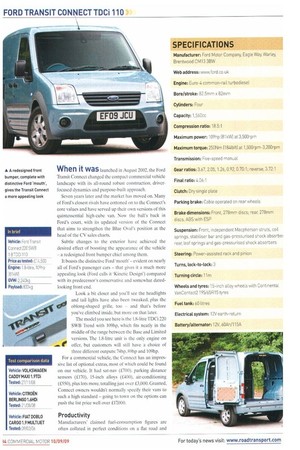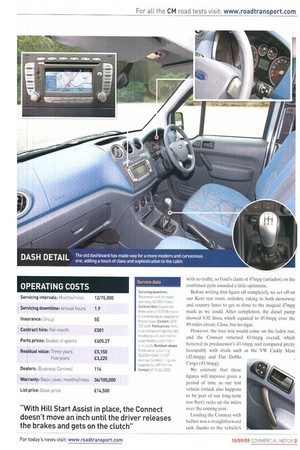When it was launched in August 2002, the Ford Transit
Page 34

Page 35

Page 36

If you've noticed an error in this article please click here to report it so we can fix it.
Connect changed the compact commercial vehicle landscape with its all-round robust construction, driverfocused dynamics and purpose-built approach.
Seven years later and the market has moved on. Many of Ford's closest rivals have cottoned on to the Connect's core values and have served up their own versions of this quintessential high-cube van. Now the ball's back in Ford's court, with its updated version of the Connect that aims to strengthen the Blue Oval's position at the head of the CV sales charts.
Subtle changes to the exterior have achieved the desired effect of boosting the appearance of the vehicle — a redesigned front bumper chief among them.
It boasts the distinctive Ford 'mouth' — evident on nearly all of Ford's passenger cars — that gives it a much more appealing look (Ford calls it 'Kinetic Design') compared with its predecessor's conservative and somewhat datedlooking front end.
Look a bit closer and you'll see the headlights and tail lights have also been tweaked, plus the oblong-shaped grille, too — and that's before you've climbed inside, but more on that later.
The model you see here is the 1.8-litre TDCi 220 SWB Trend with 109hp, which fits neatly in the middle of the range between the Base and Limited versions. The 1.8-litre unit is the only engine on offer, but customers will still have a choice of three different outputs: 7411p, 89hp and 109hp.
For a commercial vehicle, the Connect has an impressive list of optional extras, most of which could he found on our vehicle. It had sat-nay (£700). parking distance sensors (L170), 15-inch alloys (€400). air-conditioning (£550), plus lots more, totalling just over 13,000. Granted, Connect owners wouldn't normally specify their vans to such a high standard — going to town on the options can push the list price well over £17,000.
Productivity
Manufacturers' claimed fuel-consumption figures are often collated in perfect conditions on a flat road and with no traffic, so Ford's claim of 47mpg (unladen) on the combined cycle sounded a little optimistic.
Before writing that figure off completely, we set off on our Kent test route, unladen, taking in both motorway and country lanes to get as close to the magical 47mpg mark as we could. After completion, the diesel pump showed 8.92 litres, which equated to 45.6rripg over the 89-miles circuit. Close, but no cigar.
However, the true test would come on the laden run, and the Connect returned 43.6mpg overall, which bettered its predecessor's 43.1mpg, and compared pretty favourably with rivals such as the VW Caddy Maxi (42.6mpg) and Fiat Doblo Cargo (43.9mpg).
We estimate that these figures will improve given a period of time as our test vehicle (which also happens to be part of our long-term test fleet) racks up the miles over the coming year.
Loading the Connect with ballast was a straightforward task thanks to the vehicle's twin sliding side doors (a £250 option) and the rear doors, which open 250 degrees (another £250 extra).
There are six tie-down points strategically positioned across the load area to help secure items, and a PVC lining helps protect the paintwork from knocks and scrapes
Cab comfort
Forget the exterior tweaks — the biggest changes on the Connect are inside. The old dashboard makes way for a more modern and curvaceous one, which has been lifted straight from Ford's S-Max people carrier.
Soft-touch plastic dominates, and gives the van's interior a feel of class and sophistication that you don't find in rival cabins. That said. we still have our doubts concerning the toughness of the dash, especially when confronted with real-world regular usage.
Despite these criticisms, the cabin is still a comfortable place to be. The cloth seats provide the right amount of support, and it's very easy to settle into a comfortable driving position.
The raked windscreen and large side windows give the interior an airy feel, which also has its benefits with visibility. Even so. we specified rear parking sensors on our test van, and you could, in theory, park the Connect with your eyes closed — but we wouldn't like to encourage it.
Storage space is another plus point in the Connect, with ample oddment trays and binnacles dotted around the cabin.
There's even a shelf on the dashboard to store A4 files if needs dictate, and don't forget the 'secret' drawer underneath the passenger seat, too.
An expensive option on the Connect is the sat-nay system that works well, but is let down a little by the Atari-style graphics. The screen is tiny, and with all the map information jammed around it, there's only a small space left for the actual directions
On the road
The top-rated 109hp engine serves up a healthy slice of power, and even on our laden test route it never felt laboured. Powerful it may be, but the 1.8-litre unit suffers from an acute bout of turbo lag at lower revs.
In the urban environment, where low-down torque is essential for nipping through traffic, the turbo on the Connect only wakes up at about 1,800rpm, when all 109 horses seem to start galloping away. The lack of any linearity in power delivery detracts somewhat from the excellent ride that feels more hatchback than van.
While we're on the subject of engines. the 1.8-litre is noisy and that distinct diesel clatter is particularly pronounced on cold start-ups and when idling. Not even the well-insulated cabin can hide that fact.
Since our test vehicle had only covered 500 miles at the time, the gear changes were still tight and notchy. This is likely to change over time as the van beds in.
A neat feature on the Connect is the Hill Start Assist (HSA) function, which senses when the vehicle is stopped on a slope and holds it in place until the driver gets control of the clutch pedal.
With HSA in place, there's no need to use the handbrake to pull off from steep gradients, and even when the rear is fully committed, the Connect doesn't move an inch until the driver releases the brakes and gets their foot on the clutch. •




















































































































































